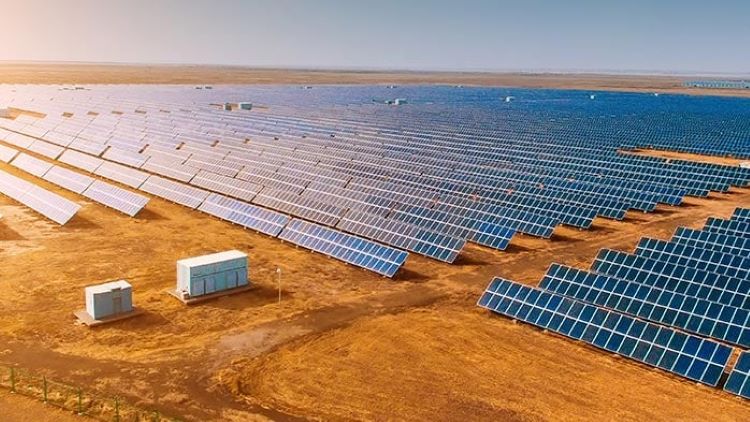Decarbonization

September 14, 2025
Market sector deep dive: Solar
Written by Greg Wittbecker
The solar panel market has been a major driver of growth in aluminum extrusions, particularly in China, where massive deployment of photovoltaic energy has taken place. In recent years, Chinese solar panel demand has topped 2 million tons per year (t/yr).
Solar 101
Some basic definitions before we dig into the subject matter. Solar photovoltaic capacity is divided through the following channels:
- Utility-scale – the largest segment of the market
- Residential – roof-mounted installations on single- and multi-family homes
- Commercial – roof-mounted installations on businesses and institutional buildings
- Community- roof- or ground-mounted installation projects and purchasing programs within a geographic area
The Solar Energy Industry Association (SEIA) reports that the U.S. added 49.9 gigawatts (GW) of solar capacity in 2024. That was comprised of:
- Utility-scale: 41.4 GW, or 83% of total installations
- Residential: 4.7 – 9.4% of total installations
- Commercial: 2.1- 4.2% of total installations
- Community: 1.7- 3.4% of total installations
Aluminum demand for the sector is comprised of:
- The frame, which averages about 8% of an installation’s weight, ranging from 70 pounds in utility-scale frames to 40 pounds for residential framing. This means between 3.2-5.6 pounds of aluminum content per frame.
- Mounting systems, which are confined to residential and commercial applications, as utility-scale capacity uses steel due to cost. Community applications are dependent on whether an installation is roof- or ground-mounted. Mounting hardware is dominated by aluminum extrusions due to weight considerations and environmental durability.
- Inverters, which convert the direct current of the panel into alternating current for use in a network, that typically utilize aluminum sheet for housing.
Demand forecasts
Some of the more optimistic forecasts of aluminum demand for solar have estimated as much as 21 metric tons per megawatt (t/MW) of capacity. This is the European Aluminum Association’s outlook.
CRU’s perspective on Europe is tempered. We believe that, optimally, frames could consume 4.6 t/MW, mountings 10.3 t/MW, and inverters 1.6 t/MW – for a total 16.5 t/MW.
CRU’s view on the U.S. market is further tempered by several factors:
- Steel is beginning to penetrate the frame market, especially in the utility-scale segment where cost is critical and weight is less of a concern.
- The 10.3 tons for mounting in Europe is based on widespread aluminum use in utility-scale, residential, commercial, and community applications. In the U.S., the utility-scale market is 100% steel, so our estimate for mounting demand is sharply lower at only 1.75 t/MW.
- Inverter demand is exclusively sheet-derived.
U.S. Solar demand suffers due to panel imports
2024 was a good news/bad news story for the solar panel market. The good news was that domestic solar module capacity jumped to 42.1 GW from 14.5 GW through the year. The bad news was that imports of solar panels were 54.3 GW.
This meant that imported panels were 108.6% of the amount of solar capacity added in 2024!
Record imports came in from Vietnam, Thailand, Malaysia, Indonesia, and Cambodia, with Indonesia and Laos joining the second half of 2024.
On paper, domestic panel production capacity was capable of meeting 84% of solar capacity installations in 2024, yet project managers elected to continue importing. Here’s some of the rationale behind the imports:
- While installed capacity was way up, these domestic plants were still in commissioning phases and not optimizing production.
- Domestic sourcing of silicon wafers, which are used to convert sunlight into electricity, was still in its’ infancy.
- Buyers were conservative in accepting domestic production and quality.
- Imported panels were still cheaper than U.S. panels.
- Tariff uncertainty with China and other Asian countries compelled importers to massively front-load panels. The pending changes in port charges on Chinese-built, owned, and operated vessels also factored in, as importers did not want to get burned with higher container freight costs.
Backing into implied domestic solar demand
It is difficult to correlate domestic demand from the total GW installations, given that much of the installed capacity has been met by imported panels.
However, we do have some frame of reference in that leading industry data sets indicate that total aluminum shipments to solar around 45 million pounds.
Here’s our take on how that demand breaks down:
- If we take the 49.9 GW of 2024 installations and deduct utility-scale installations, we have 8.5 GW of capacity that needed aluminum mountings.
- 8.5 GW = 8,500 MW x 1.75 tons = 14,875 metric tons= 32.8 million pounds
- If we deduct mounting demand from the estimated 45 million pounds of aggregate demand, we get an implied demand of 12.2 million pounds for the frame market.
Outlook for remainder of 2025 and 2026
SEIA reports that installations are slowing quickly. Q2 2025 saw 7.5 GW of capacity installed, down 28% from Q1 2025 and 24% from Q2 2024.
Residential installations fell by 3% from Q1 2025 and by 9% from Q2 2024. Commercial installations were strong, rising 27% year-on-year, thanks to a very strong performance in California. Community installations cratered, falling 34% from Q1 2025 and 52% from Q2 2024.
Utility-scale installations, which have been the major engine of growth, fell 33% from Q1 and 28% from Q2 2024.
One Big Beautiful Bill Act (OBBBA) strips incentives
The OBBBA singlehandedly changed the momentum of the solar sector. Access to Section 48E and 45Y tax credits are gone after 2027, and Section 25D credits for consumers are gone after 2025.
Residential installations will decrease slightly in 2025, following a 30% market contraction in 2024, as high interest rates and other market headwinds temper consumer demand.
Commercial solar capacity will fall by 4% this year compared to 2024.
The community solar market will experience significant contraction, with capacity declining by 22% year-over-year in 2025, following a record year in 2024.
Utility-scale installations will drop by 2% in 2025 after two solid years of growth. Policy and tariff uncertainty are resulting in a contraction in the segment’s pipeline, impacting near-term growth.
The U.S. solar industry is projected to contract by 2% annually between 2025 and 2030 in SEIA’s base case. However, this still could mean an aggregate 246 GW of installations – or an average of 41 GW per year.
Why This Matters
The solar market has been a source of steady demand for extruders in the past two years, thanks to mounting systems. Sheet mills have also benefited from the inverter demand for housings.
One has to think that there is substantial upside potential for frame demand.
Domestic panel manufacturing is now at a point where it can meet domestic demand.
However, installers have been reluctant to wean themselves off imported panels due to cost and uncertainty over domestic performance.
New tariffs and higher container freight may break that bias and lead to a dramatic shift towards domestic sourcing.
Now, the challenge for the industry is to survive the effects of the OBBBA and rationalize new installations without the aid of Federal incentives. That will be a challenge.
However, with 41 GW per annum of installations still in the forecast, there is a nice chunk of demand available to domestic panel makers, who may finally get their chance to compete at the expense of imports.








